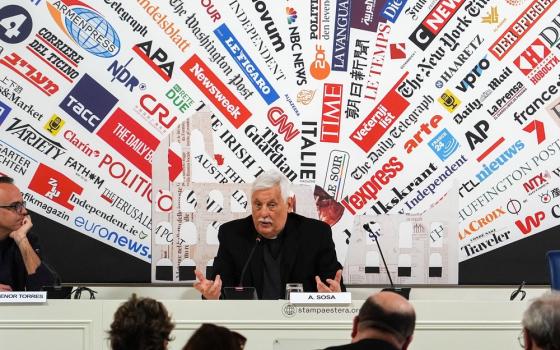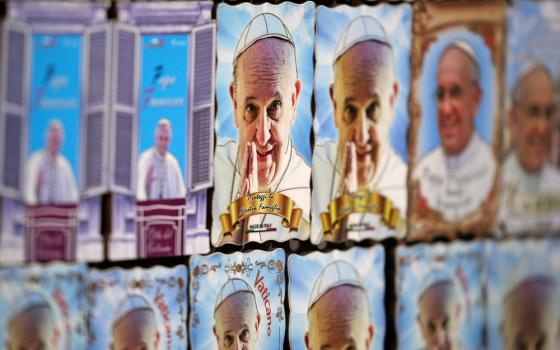In what may be the final act of the long-running Catholic drama centering on Zambian Archbishop Emmanuel Milingo, the Vatican announced today that Milingo has been formally removed from the clerical state – in layman’s terms, defrocked.
As today’s Vatican statement noted, such a step is highly unusual for a bishop. The Vatican said it was compelled to act because of Milingo’s “persistent contumacy,” especially his decision to ordain several bishops without papal permission for his “Married Priests Now!” movement, which seeks to promote optional celibacy in the Catholic church.
The last case of a bishop being removed from the clerical state came in 2008, with Fernando Lugo, the president of Paraguay and former Bishop of San Pedro who resigned in 2005 in order to pursue a political career. Lugo had requested laicization in 2006 but the Vatican had consistently refused, relenting only after he won the presidency in April 2008.
Milingo had been considered excommunicated since 2006 on account of his defiance of church authority.
In Catholic theology, ordinations by a bishop without papal authorization are considered valid but illicit – meaning that the men ordained by Milingo are really bishops, but they have no authority to exercise any ministry. Today’s Vatican statement indicated that the Catholic church does “not recognize these ordinations, nor does she intend to recognize them, or any subsequent ordinations based on them,” and that “the canonical status of the supposed bishops remains as it was.”
A Vatican spokesperson said this morning that since Milingo has been removed from the clerical state, any future ordinations he performs will be not only illict, but invalid.
Milingo, who was made a bishop by Pope Paul VI in 1969 at the age of 39, had long been a thorn in the side of church authorities because of his controversial practice of mass exorcism ceremonies. During much of the 1980s and 1990s, he was one of the highest-profile Catholic prelates in the world because of his best-selling musical CDs and his international reputation as an exorcist and faith healer.
In 2001, Milingo broke away from the Catholic church and wed a follower of Moon, a then-43 Korean acupuncturist named Maria Sung. After a tempestuous few weeks, including a surprise meeting with Pope John Paul II at his summer residence of Castel Gandolfo, Milingo returned to obedience.
He was allowed to resume a limited form of his healing ministry outside Rome.
In 2006, however, Milingo disappeared from Italy and reappeared in the United States at the side of Archbishop George Stallings, leader of his own breakaway group, the African American Catholic Congregation, based in Washington, D.C., as well as followers of Rev. Sun Myung Moon.
Shortly thereafter, Milingo launched his “Married Priests Now!” movement, while insisting that he had no intention of launching a “new sect.”
The following is the full text of today’s Vatican announcement.
Communication of the Press Office of the Holy See: Removal from the Clerical State of Emmanuel Milingo
For a number of years the Church has followed with great concern the difficulties caused by the regrettable conduct of Archbishop Emmanuel Milingo. Many attempts have been made to bring Archbishop Milingo back into communion with the Catholic Church, including the consideration of suitable ways to enable him to exercise the episcopal ministry. Pope John Paul II and Pope Benedict XVI were directly involved in those efforts and both Popes personally followed the case of Archbishop Milingo in a spirit of paternal solicitude.
In the course of this unhappy series of events, Archbishop Milingo became irregular in 2001 as a result of his attempt to marry Mrs. Maria Sung, and incurred the medicinal penalty of suspension (cf. Canons 1044 § 1, n. 3; 1394 § 1 of the Code of Canon Law). Thereafter, he headed certain groups calling for the abolition of clerical celibacy and gave numerous interviews to the media in open disobedience to the repeated interventions of the Holy See, creating serious upset and scandal among the faithful. Then, on 24 September 2006 in Washington, Archbishop Milingo ordained four Bishops without pontifical mandate.
By so doing, he incurred the penalty of excommunication latae sententiae (Canon 1382) which was declared by the Holy See on 26 September 2006 and is still in force today. Sadly, Archbishop Milingo has shown no sign of the desired repentance with a view to returning to full communion with the Supreme Pontiff and the other members of the College of Bishops. Rather, he has persisted in the unlawful exercise of acts belonging to the episcopal office, committing new crimes against the unity of Holy Church. Specifically, in recent months Archbishop Milingo has proceeded to several other episcopal ordinations.
The commission of these grave crimes, which has recently been established, is to be considered as proof of the persistent contumacy of Archbishop Emmanuel Milingo. The Holy See has therefore been obliged to impose upon him the further penalty of dismissal from the clerical state.
According to Canon 292 of the Code of Canon Law, the penalty of dismissal from the clerical state, now added to the grave penalty of excommunication, has the following effects: loss of the rights and duties attached to the clerical state, except for the obligation of celibacy; prohibition of the exercise of any ministry, except as provided for by Canon 976 of the Code of Canon Law in those cases involving danger of death; loss of all offices and functions and of all delegated power, as well as prohibition of the use of clerical attire. Consequently, the participation of the faithful in any future celebrations organized by Archbishop Emmanuel Milingo is to be considered unlawful.
It must be pointed out that the dismissal of a Bishop from the clerical state is most extraordinary. The Holy See has felt obliged to act in this way due to the serious consequences for ecclesial communion resulting from repeated episcopal consecrations carried out without pontifical mandate; nevertheless, the Church hopes that Archbishop Milingo will see the error of his ways.
As for those recently ordained by Archbishop Milingo, the Church’s discipline in imposing the penalty of excommunication latae sententiae upon those who receive episcopal consecration without pontifical mandate is well-known. While expressing hope for their conversion, the Church reaffirms what was declared on 26 September 2006, namely that she does not recognize these ordinations, nor does she intend to recognize them, or any subsequent ordinations based on them, in the future. Hence the canonical status of the supposed bishops remains as it was prior to the ordination conferred by Archbishop Milingo.
At this moment, as the Church experiences profound sorrow for the grave acts perpetrated by Archbishop Milingo, she entrusts to the power of prayer the repentance of the guilty party and of all those who - be they priests or lay faithful - have in any way cooperated with him by acting against the unity of Christ’s Church.



